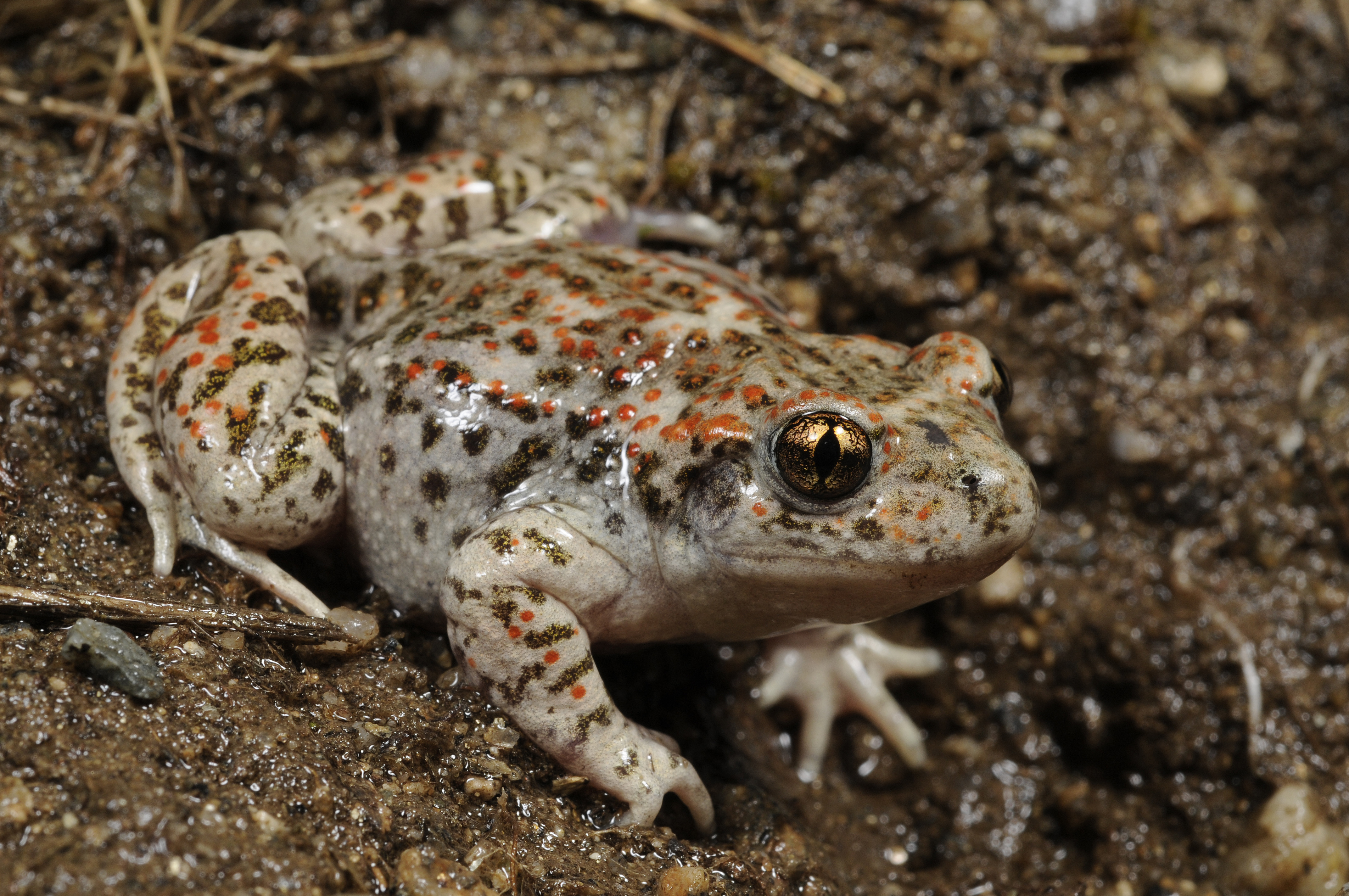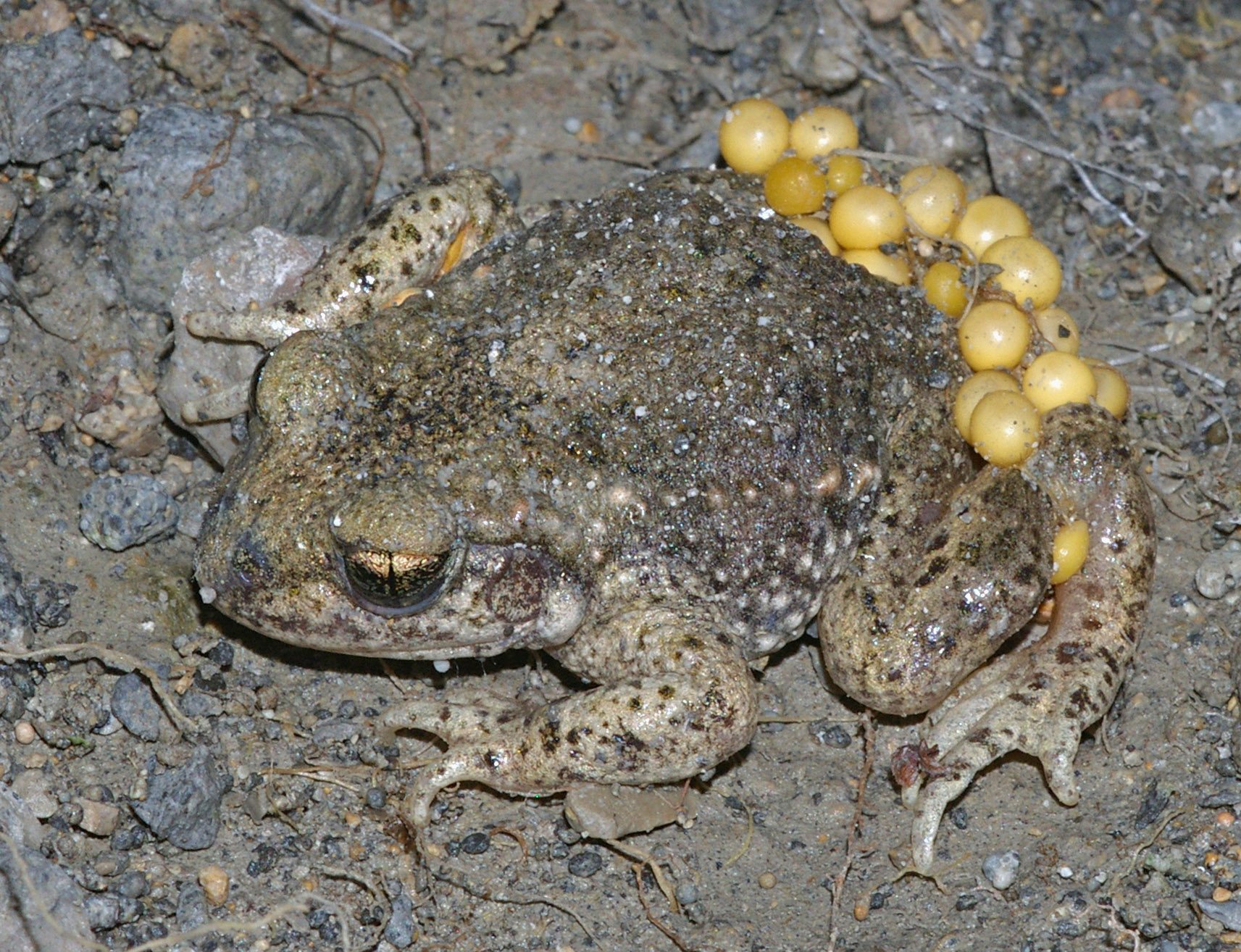|
Midwife Toad
Midwife toads are a genus (''Alytes'') of frogs in the family Alytidae (formerly Discoglossidae), and are found in most of Europe and northwestern Africa. Characteristic of these toad-like frogs is their parental care; the males carry a string of fertilised eggs on their backs, hence the name "midwife". The female expels a strand of eggs, which the male fertilizes externally. He then wraps them around his legs to protect them from predators in the water. When they are ready to hatch, the male wades into shallow water, where he allows the tadpoles to leap out of their eggs. Five separate species of midwife toads are found across western Europe, northern Africa, and Majorca. Midwife toads can be found in the snows of the Pyrenees, living at heights of 5,000–6,500 feet in areas such as the Néouvielle massif. Unlike the thin tongue of many amphibians, the midwife's tongue is round and flattened; its former family name, Discoglossidae, means "round tongue". In parts of France, midwi ... [...More Info...] [...Related Items...] OR: [Wikipedia] [Google] [Baidu] |
Alytes Obstetricans
The common midwife toad (''Alytes obstetricans'') is a species of midwife frog in the family Alytidae (formerly Discoglossidae). It is found in Belgium, France, Germany, Luxembourg, the Netherlands, Portugal, Spain, Switzerland, and the United Kingdom (although, in the latter, only as an introduction). Like other members of its genus (''Alytes''), the male toad carries the eggs around entwined on his back and thighs until they are ready to hatch. Its natural habitats are temperate forests, dry forests, shrubland, rivers, freshwater lakes, freshwater marshes, temperate desert, arable land, pastureland and urban areas. It is threatened by habitat loss. Description The common midwife toad can grow to a length of but is usually rather smaller than this, the females generally being larger than the males. It is broad and stocky and has a large head with prominent eyes, the pupils being vertical slits. The skin is mostly smooth with a few small warts and granules and a row of larg ... [...More Info...] [...Related Items...] OR: [Wikipedia] [Google] [Baidu] |
Natterjack Toad
The natterjack toad (''Epidalea calamita'') is a toad native to sandy and heathland areas of Europe. Adults are 60–70 mm in length, and are distinguished from common toads by a yellow line down the middle of the back and parallel paratoid glands. They have relatively short legs, which gives them a distinctive gait, contrasting with the hopping movement of many other toad species. Natterjacks have a very loud and distinctive mating call amplified by the single vocal sac found under the chin of the male. Life history Natterjacks live for up to 15 years, and feed mainly on insects, especially beetles. At night, they move around open terrain with sparse vegetation, and their tracks can often be seen in loose sand. They move considerable distances each night, enabling the species to colonize new habitats very quickly. Reproduction The natterjack toad spawns between the end of April and July, laying strings of eggs in shallow, warm pools. Because the natterjack toad is oft ... [...More Info...] [...Related Items...] OR: [Wikipedia] [Google] [Baidu] |
Painted Frogs
Painted frog may refer to: *'' Atelopus ebenoides'' – from Central America *''Discoglossus pictus'' – from the central Mediterranean region. *'' Neobatrachus pictus'' – from southern Australia *'' Neobatrachus sudelli'' – from eastern Australia *'' Discoglossus nigriventer'' *''Kaloula pulchra'' *''Discoglossus pictus The Mediterranean painted frog or simply painted frog (''Discoglossus pictus'') is a species of frog in the family Alytidae (formerly Discoglossidae). Distribution ''Discoglossus pictus'' is found Mediterranean Africa in northeast Morocco, north ...'' – from Africa {{disambiguation Animal common name disambiguation pages ... [...More Info...] [...Related Items...] OR: [Wikipedia] [Google] [Baidu] |
Arthur Koestler
Arthur Koestler, (, ; ; hu, Kösztler Artúr; 5 September 1905 – 1 March 1983) was a Hungarian-born author and journalist. Koestler was born in Budapest and, apart from his early school years, was educated in Austria. In 1931, Koestler joined the Communist Party of Germany, but he resigned in 1938 after becoming disillusioned with Stalinism. Having moved to Britain in 1940, he published his novel ''Darkness at Noon'', an anti-totalitarian work that gained him international fame. Over the next 43 years, Koestler espoused many political causes and wrote novels, memoirs, biographies, and numerous essays. In 1949, Koestler began secretly working with a British Cold War anti-communist propaganda department known as the Information Research Department (IRD), which would republish and distribute many of his works, and also fund his activities. In 1968, he was awarded the Sonning Prize "for [his] outstanding contribution to European culture". In 1972 he was made a Order of the Briti ... [...More Info...] [...Related Items...] OR: [Wikipedia] [Google] [Baidu] |
Paul Kammerer
Paul Kammerer (17 August 1880, in Vienna – 23 September 1926, in Puchberg am Schneeberg) was an Austrian biologist who studied and advocated Lamarckism, the theory that organisms may pass to their offspring characteristics acquired in their lifetime. Biography Education He began his academic career at the Vienna Academy by studying music but graduated with a degree in biology.Koestler, Arthur (1973). ''The Case of the Midwife Toad''. Vintage (first published 1971). Biological research Kammerer's work in biology largely involved altering the breeding and development of amphibians. He made ovoviviparous fire salamanders become viviparous, and viviparous alpine salamanders become ovoviviparous. In lesser-known experiments, he manipulated and bred olms. He made olms produce live young and bred dark-colored olms with full vision. He supported the Lamarckian theory of heritability of acquired characteristics, and he experimented extensively in an effort to prove the theory. Kamm ... [...More Info...] [...Related Items...] OR: [Wikipedia] [Google] [Baidu] |
Carl Vogt
August Christoph Carl Vogt (; 5 July 18175 May 1895) was a German scientist, philosopher, popularizer of science, and politician who emigrated to Switzerland. Vogt published a number of notable works on zoology, geology and physiology. All his life he was engaged in politics, in the German Frankfurt Parliament of 1848–49 and later in Switzerland. Early life Vogt was born in Giessen, the son of , professor of clinics, and Louise Follenius. His maternal uncle was Charles Follen. From 1833 to 1836, he studied medicine at the University of Giessen, and continued his training in Berne, Switzerland, earning his PhD. in 1839. He then worked with Louis Agassiz in Neuchâtel. Career In 1847 he became professor of zoology at the University of Giessen, and in 1852 professor of geology and afterwards also of zoology at the University of Geneva. His earlier publications were on zoology. He dealt with the Amphibia (1839), Reptiles (1840), with Mollusca and Crustacea (1845) and more gener ... [...More Info...] [...Related Items...] OR: [Wikipedia] [Google] [Baidu] |
Programmed Cell Death
Programmed cell death (PCD; sometimes referred to as cellular suicide) is the death of a cell as a result of events inside of a cell, such as apoptosis or autophagy. PCD is carried out in a biological process, which usually confers advantage during an organism's lifecycle. For example, the differentiation of fingers and toes in a developing human embryo occurs because cells between the fingers apoptose; the result is that the digits are separate. PCD serves fundamental functions during both plant and animal tissue development. Apoptosis and autophagy are both forms of programmed cell death. Necrosis is the death of a cell caused by external factors such as trauma or infection and occurs in several different forms. Necrosis was long seen as a non-physiological process that occurs as a result of infection or injury, but in the 2000s, a form of programmed necrosis, called necroptosis, was recognized as an alternative form of programmed cell death. It is hypothesized that necroptosis ... [...More Info...] [...Related Items...] OR: [Wikipedia] [Google] [Baidu] |
Apoptosis
Apoptosis (from grc, ἀπόπτωσις, apóptōsis, 'falling off') is a form of programmed cell death that occurs in multicellular organisms. Biochemical events lead to characteristic cell changes (morphology) and death. These changes include blebbing, cell shrinkage, nuclear fragmentation, chromatin condensation, DNA fragmentation, and mRNA decay. The average adult human loses between 50 and 70 billion cells each day due to apoptosis. For an average human child between eight and fourteen years old, approximately twenty to thirty billion cells die per day. In contrast to necrosis, which is a form of traumatic cell death that results from acute cellular injury, apoptosis is a highly regulated and controlled process that confers advantages during an organism's life cycle. For example, the separation of fingers and toes in a developing human embryo occurs because cells between the digits undergo apoptosis. Unlike necrosis, apoptosis produces cell fragments called apoptotic ... [...More Info...] [...Related Items...] OR: [Wikipedia] [Google] [Baidu] |
Benny Trapp Alytes Dickhilleni
Benny or Bennie is a given name or a shortened version of the given name Benjamin or, less commonly, Benedict, Bennett, Benito, Benson, Bernice, Ebenezer or Bernard. People Bennie Given name *Bennie M. Bunn (1907–1943), American Marine officer, Navy Cross recipient *Bennie Cunningham (born 1954), American retired National Football League player * Bennie Daniels (born 1932), American former Major League Baseball pitcher * Bennie L. Davis (1928–2012), United States Air Force general and commander-in-chief of Strategic Air Command * Bennie Ellender (1925–2011), American college football player and head coach * Bennie Goods (born 1968), American retired Canadian Football League player * Bennie Green (1923–1977), American jazz trombonist and bandleader * Bennie Logan (born 1989), American National Football League player * Bennie Maupin (born 1940), American jazz musician * Bennie Muller (born 1948), Dutch former footballer * Bennie Purcell (born 1929), American college basket ... [...More Info...] [...Related Items...] OR: [Wikipedia] [Google] [Baidu] |
Benny Trapp Alytes Cisternasii
Benny or Bennie is a given name or a shortened version of the given name Benjamin or, less commonly, Benedict, Bennett, Benito, Benson, Bernice, Ebenezer or Bernard. People Bennie Given name *Bennie M. Bunn (1907–1943), American Marine officer, Navy Cross recipient *Bennie Cunningham (born 1954), American retired National Football League player * Bennie Daniels (born 1932), American former Major League Baseball pitcher * Bennie L. Davis (1928–2012), United States Air Force general and commander-in-chief of Strategic Air Command * Bennie Ellender (1925–2011), American college football player and head coach * Bennie Goods (born 1968), American retired Canadian Football League player * Bennie Green (1923–1977), American jazz trombonist and bandleader * Bennie Logan (born 1989), American National Football League player * Bennie Maupin (born 1940), American jazz musician * Bennie Muller (born 1948), Dutch former footballer * Bennie Purcell (born 1929), American college basket ... [...More Info...] [...Related Items...] OR: [Wikipedia] [Google] [Baidu] |





